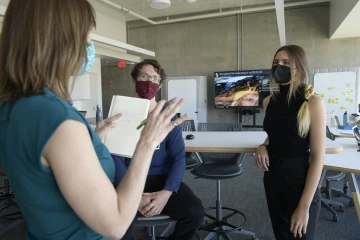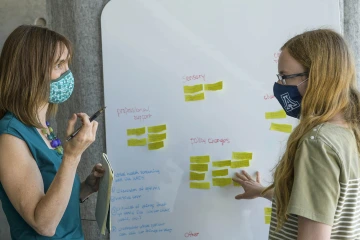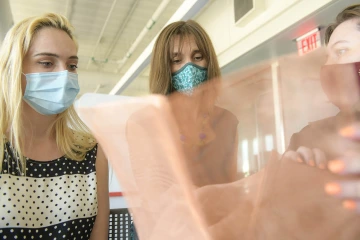Designing Creative Solutions to Health Care Challenges
A new UArizona Health Sciences class is preparing students from across the university to creatively solve health care challenges using design thinking.
Approximately 1 in 10 people will suffer from kidney stones at some point in their lives, experiencing symptoms such as severe lower back pain, blood in the urine, nausea, vomiting, and fever and chills as a result.
Having an opportunity to work on an actual health care problem like kidney stones was exactly what Bridget Slomka was looking for when she signed up for a new University of Arizona Health Sciences class that teaches students an innovative way to approach problem solving.

Tom Knapp and Bridget Slomka listen as Kasi Kiehlbaugh, PhD, talks through a concept during a Design for Care Workshop: Addressing Health Care Challenges with Design Thinking class.
“The treatment for kidney stones is so painful,” Slomka said. “It’s time consuming and repetitive. We said, ‘What if we prevented them in the first place?’”
Together with fellow biomedical engineering graduate student Tom Knapp, Slomka created a project that used design thinking to identify new solutions to reduce the risk of kidney stone development and recurrence. She was aware of a calcium plaque, known as Randall’s plaque, that is linked to the chronic formation of kidney stones.
“There is a whole field of medicine for people recurrently suffering from the condition, and there's a lot of potential for improvement,” Knapp said.
By applying design thinking skills, Slomka and Knapp arrived at their solution for kidney stones: targeted microbubble therapy. Microbubbles deliver drugs to targets in the body. Once they reach their intended target – in this case, the Randall’s plaque – ultrasound can be used to burst the bubbles and release a drug to reduce or prevent the plaque formation
Design in problem solving
“Design thinking is about learning how to creatively approach problems,” said Kasi Kiehlbaugh, PhD, director of the Health Sciences Design program.

Dr. Kiehlbaugh assists a student through the ideation process, which is one of the five basic concepts of design thinking: empathize, define, ideate, prototype and test.
Dr. Kiehlbaugh also teaches Design for Care Workshop: Addressing Healthcare Challenges with Design Thinking, which focuses on a human-centered process to creatively address unique problems. Undergraduate and graduate students learn how to apply design thinking principles, as well as experiential and project-based collaborative learning, to solve health and wellness challenges.
She structured the inaugural course as a workshop, meeting once a week for two-and-a-half hours. Her class of seven students included six biomedical engineering students and one speech, language and hearing sciences doctoral student. The first phase of the class covered the design thinking process, after which students focused on individual and team projects.
The design thinking toolkit
The basic principles of design thinking center on five concepts: empathize, define, ideate, prototype and test. However, there is not a rigid structure for how to approach a problem.
“Design thinking is about learning how to creatively approach problems.”Kasi Kiehlbaugh, PhD
“It’s definitely not a set of steps you follow,” Dr. Kiehlbaugh said. “It’s about giving students the confidence to know when, where and how to use these skills in any situation they encounter.”
At the heart of the design thinking process is the skill of empathy, the ability to fully understand the problem someone is facing. This can include why something is of concern to a person, how they face and encounter the problem, and how the problem affects that person. These answers then shape the ideating process, which is similar to brainstorming.
“Ideating is meant to be a broader understanding in that space where you’re trying to generate new ideas that encompass a lot of other tools,” Dr. Kiehlbaugh said.

Students utilize a variety of materials to develop prototypes and test ideas during the class.
Those tools include strategies such as lateral brainstorming, which uses a random word to stimulate new ideas. Another valuable method is journey mapping, a process Dr. Kiehlbaugh says allows students to “visually represent the emotional journey and the physical journey of the person at the center of the problem.”
Slomka and Knapp put these tools to use for their kidney stone team project.
“One of us took the patient's perspective, the other one took the physician's perspective,” Slomka said. “We would ask how this treatment integrates and how does it appear to both of these different groups?"
Making an impact
Some class projects, like Slomka and Knapp’s, were conceptual, some were carried out through prototyping, and others were ready to produce real-world solutions.
One group of students discussed some of the logistical challenges faced by COVID-19 vaccine point of distribution sites, such as the one at UArizona. They considered solutions to more efficiently train volunteers, such as using simple videos to cover basic on-boarding and procedures for various jobs.
The idea was accepted and implemented.
“This demonstrated they could work to create solutions to address specific needs and present them to university leadership or state-level leadership,” Dr. Kiehlbaugh said.

At the end of the semester, students present their projects to a panel of faculty members from different colleges and disciplines.
In future semesters, Dr. Kiehlbaugh envisions classes that include not only students from the five Health Sciences colleges, but also students from a variety of academic backgrounds, including English, humanities, drama, math and other departments across campus. The value of this kind of intellectual diversity was seen first-hand as students were brainstorming new ways to administer COVID-19 vaccines and reduce vaccine hesitancy.
The six biomedical engineering students approached the topic based on the continued use of a traditional injectable vaccine. But Bryan Wong, a student in the Department of Speech, Language and Hearing Sciences, looked at vaccine delivery differently and contributed a few more novel ideas: What if the vaccine could be administered as an inhalable shot or edible?
That is the kind of creative problem-solving needed to solve the biggest health care challenges, and Dr. Kiehlbaugh believes design thinking can help make it happen.
“Human health is a universal thing we all care about,” Dr. Kiehlbaugh said. “That is what is a great about an open program like this. It is a place where interprofessional education can happen in a really organic and exciting way.”
Extras
Our Experts
Contact
Blair Willis
520-419-2979
bmw23@arizona.edu
Health Sciences
Office of Communications
520-626-7301
public@arizona.edu

